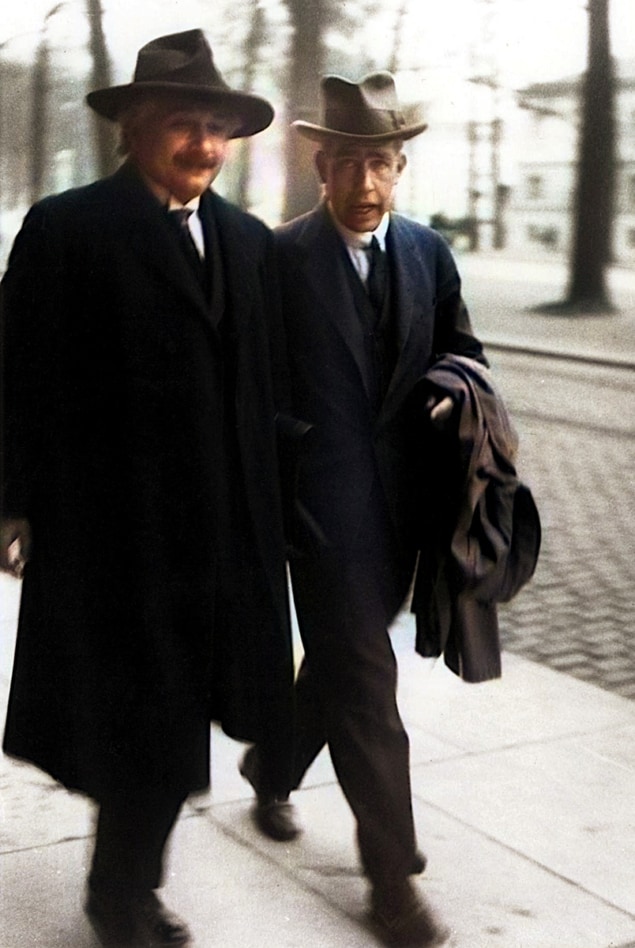
Next year sees the centenary of the summer in which German theoretical physicist Werner Heisenberg sought refuge from hay fever on the North Sea island of Helgoland. There, he figured out how to express the perplexing spectroscopic observations of atoms – whereby they absorbed and emitted light at well-defined, characteristic frequencies – in mathematical form. Heisenberg’s mentor, Danish physicist Niels Bohr, had proposed that the spectra could be understood on the assumption that an atom’s electrons may possess only specific energies, switching from one energy level to another by emitting or absorbing a single “quantum” of light with an energy proportional to its frequency. That quantum hypothesis for light had been proposed by Albert Einstein in 1905, and Bohr had developed it into a new theory of the atom – albeit one that made no sense in classical terms.
By expressing the permitted energies of these “quantum jumps” as a matrix of experimentally observed values, Heisenberg transformed the ad hoc, nascent quantum theory into a genuine quantum mechanics. His matrix algebra implied that it was not possible to simultaneously know both the position and the momentum of a particle with arbitrary accuracy. This “uncertainty principle” suggested that quantum physics imposed limits on the knowledge we can have about the atomic world.
Bohr, Heisenberg and their collaborators in Copenhagen went on to argue that this restriction is fundamental. It is not that we are doomed to remain ignorant about exactly how things are, but rather that there is no meaningful “how things are” until they are measured. The suggestion sparked a good-natured but trenchant argument between Bohr and Einstein that lasted for much of their shared lifetime. “Einstein could not make the concession. It would rub out separate, individual objects, essential traits of an acceptable world picture,” write John Heilbron and Jim Baggott in their new book Quantum Drama: From the Bohr-Einstein Debate to the Riddle of Entanglement. Baggott, a physicist and science writer, and Heilbron, a historian of science who died in 2023, tell the history of quantum mechanics, from its inception to today’s cutting edge of quantum information technology.

Einstein never tired of concocting new objections to the “Copenhagen” view. At the Solvay Conference of 1930 in Belgium, which brought together the leading physicists of the day, he confronted Bohr with a paradoxical thought experiment involving a heavy box hanging from a spring, containing a photon (that escapes) and a fixed clock. Bohr produced a response to the puzzle that assuaged many doubts but seems not to have satisfied Bohr himself. “He fretted over it for the rest of his life,” say Heilbron and Baggott. “A rough sketch of the apparatus was on his blackboard the day he died.”
Einstein’s opposition exposed the deeply counterintuitive nature of quantum mechanics – most famously in a thought experiment devised in 1935 with his younger colleagues Boris Podolsky and Nathan Rosen. This “EPR [Einstein–Podolsky–Rosen] experiment” showed that, once two particles have interacted, quantum mechanics seemed to insist that their properties thereafter remain interdependent, such that a measurement elicits impossible instantaneous signalling between the two. Erwin Schrödinger, who shared Einstein’s antipathy to the Copenhagen view, named this effect “entanglement”.
To Einstein, the EPR paradox could be resolved only by assuming that the entangled particles had fixed properties all along, albeit ones that were unobservable and thus characterized by “hidden variables”. The problem was that both Bohr’s and Einstein’s interpretations made identical experimental predictions. With no obvious way to resolve the question, it was set aside, and many researchers in the 1940s and 1950s deemed such “foundational” questions pointless or even unseemly. Who cared, when quantum mechanics worked so well in practice? This was the attitude famously characterized by American physicist David Mermin as “shut up and calculate”, which was particularly dominant in the pragmatic US. Taking an interest in such issues could be tantamount to career suicide. “You’ll never get a PhD if you allow yourself to be distracted by such frivolities,” Mermin was told at Harvard, according to the book. He remarks that “it was a very unphilosophical time”.
Nobel laureate Murray Gell-Mann charged Bohr with having brainwashed a generation of physicists into thinking that the puzzles of quantum mechanics had all been long solved
In her 1999 book Quantum Dialogue, historian of science Mara Beller accused Bohr and his colleagues of imposing their Copenhagen orthodoxy and marginalizing or ridiculing alternative interpretations such as David Bohm’s “pilot waves” and Hugh Everett’s “universal wavefunction”, also known as the “many worlds” interpretation of quantum mechanics. Nobel laureate Murray Gell-Mann charged Bohr with having brainwashed a generation of physicists into thinking that the puzzles of quantum mechanics had all been long solved. But Heilbron and Baggott show that it’s fairer to lay the blame on the apathy of the community at large. As Paul Dirac said of the theory’s metaphysical conundrums: “Many people live long and fruitful lives without ever worrying about [them].”

Thirty years of ‘against measurement’
That attitude began to change, however, in 1964 when the Northern Irish physicist John Bell figured out a way to distinguish the so-called hidden-variables models from no-frills quantum mechanics. All it needed was some serious thought – “There was nothing in Bell’s inequality that was not known to the quantum founders,” the authors say.
Ironically, Bell came up with his celebrated test because he wanted to find a flaw in Bohrian quantum mechanics. So did the first person to conduct the test experimentally, John Clauser, working with Stuart Freedman at the University of California at Berkeley. Yet that experiment, and the many others later carried out, have unfailingly supported quantum mechanics alone and ruled out any hidden variables – at least those that apply locally to assign each particle fixed properties at a given position before measurement. (That does not mean Bohr is right, although it seems nearly impossible to salvage Einstein’s position.) The book gives a superb account of the resurgence of interest in quantum foundations that followed from the work of Bell and Clauser, involving in particular Clauser’s fellow 2022 Nobel laureates Anton Zeilinger and Alain Aspect. Far from being empty philosophizing, such studies now undergird technologies such as quantum computing and quantum cryptography.
Quantum Drama tells a complex story with a vast cast. While the authors sometimes demand a lot from their readers, I have never read a better account: balanced, authoritative and spiced with elegant wit. Describing a trip to Japan made by several of the early quantum pioneers, Heilbron and Baggott describe how on a walk past a pagoda “Heisenberg spontaneously climbed it and, standing on its very apex (width ∆q) on one foot in a howling wind, happily maintained an uncertainty ∆p too small to knock him over.”
This book won’t be all things to all people. As with Heilbron’s earlier book Niels Bohr: A Very Short Introduction, its description of the Bohr atom is so technical as to be nigh impenetrable to all but specialists, creating a formidable hurdle so early in the book. And there are other occasions, such as in the descriptions of Bell tests, where one longs for a pithy summary of qualitative meaning among the details. At times the reader is thrown a succession of comments from experts without much indication of how to navigate their contradictions.
But if this makes the book occasionally challenging for the general reader, the payoff for perseverance is considerable. As the author of a popular-level account of quantum mechanics, I hesitate to suggest leaving such efforts aside in favour of this more substantial volume – but I would certainly recommend treating all such accounts with caution until you have read this one.
- 2024 Oxford University Press 352pp £25hb
- SEO Powered Content & PR Distribution. Get Amplified Today.
- PlatoData.Network Vertical Generative Ai. Empower Yourself. Access Here.
- PlatoAiStream. Web3 Intelligence. Knowledge Amplified. Access Here.
- PlatoESG. Carbon, CleanTech, Energy, Environment, Solar, Waste Management. Access Here.
- PlatoHealth. Biotech and Clinical Trials Intelligence. Access Here.
- Source: https://physicsworld.com/a/entangled-entities-bohr-einstein-and-the-battle-over-quantum-fundamentals/



